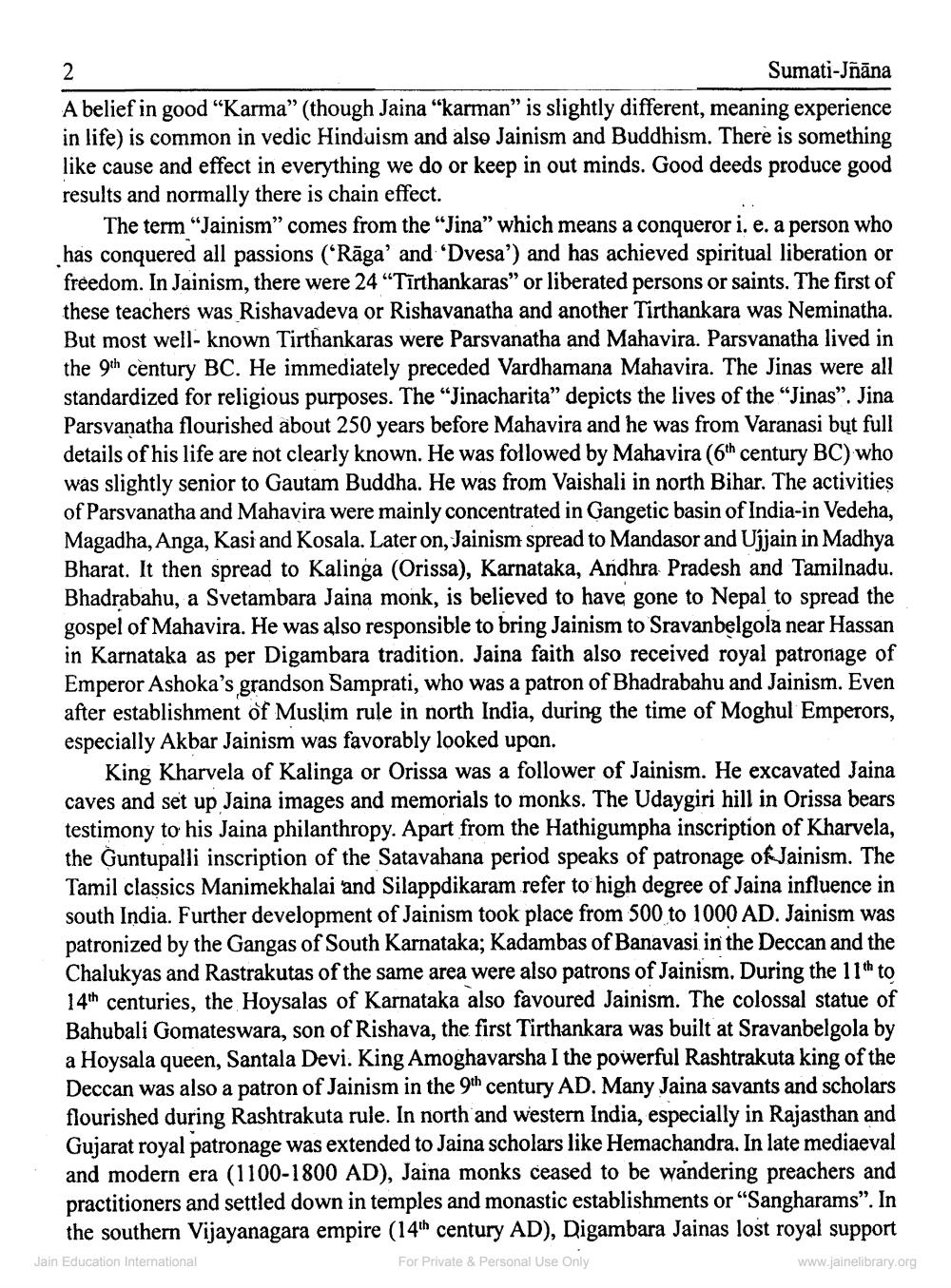________________
Sumati-Jñāna A belief in good "Karma" (though Jaina "karman" is slightly different, meaning experience in life) is common in vedic Hinduism and also Jainism and Buddhism. There is something like cause and effect in everything we do or keep in out minds. Good deeds produce good results and normally there is chain effect.
The term "Jainism" comes from the "Jina" which means a conqueror i. e. a person who has conquered all passions (“Rāga' and 'Dvesa') and has achieved spiritual liberation or freedom. In Jainism, there were 24 "Tīrthankaras" or liberated persons or saints. The first of these teachers was Rishavadeva or Rishavanatha and another Tirthankara was Neminatha. But most well-known Tirthankaras were Parsvanatha and Mahavira. Parsvanatha lived in the 9th century BC. He immediately preceded Vardhamana Mahavira. The Jinas were all standardized for religious purposes. The "Jinacharita” depicts the lives of the “Jinas”. Jina Parsvanatha flourished about 250 years before Mahavira and he was from Varanasi but full details of his life are not clearly known. He was followed by Mahavira (6th century BC) who was slightly senior to Gautam Buddha. He was from Vaishali in north Bihar. The activities of Parsvanatha and Mahavira were mainly concentrated in Gangetic basin of India-in Vedeha, Magadha, Anga, Kasi and Kosala. Later on, Jainism spread to Mandasor and Ujjain in Madhya Bharat. It then spread to Kalinga (Orissa), Karnataka, Andhra Pradesh and Tamilnadu. Bhadrabahu, a Svetambara Jaina monk, is believed to have gone to Nepal to spread the gospel of Mahavira. He was also responsible to bring Jainism to Sravanbelgola near Hassan in Karnataka as per Digambara tradition. Jaina faith also received royal patronage of Emperor Ashoka's grandson Samprati, who was a patron of Bhadrabahu and Jainism. Even after establishment of Muslim rule in north India, during the time of Moghul Emperors, especially Akbar Jainism was favorably looked upon.
King Kharvela of Kalinga or Orissa was a follower of Jainism. He excavated Jaina caves and set up Jaina images and memorials to monks. The Udaygiri hill in Orissa bears testimony to his Jaina philanthropy. Apart from the Hathigumpha inscription of Kharvela, the Guntupalli inscription of the Satavahana period speaks of patronage of Jainism. The Tamil classics Manimekhalai and Silappdikaram refer to high degree of Jaina influence in south India. Further development of Jainism took place from 500 to 1000 AD. Jainism was patronized by the Gangas of South Karnataka; Kadambas of Banavasi in the Deccan and the Chalukyas and Rastrakutas of the same area were also patrons of Jainism. During the 11th to
turies, the Hoysalas of Karnataka also favoured Jainism. The colossal statue of Bahubali Gomateswara, son of Rishava, the first Tirthankara was built at Sravanbelgola by a Hoysala queen, Santala Devi. King Amoghavarsha I the powerful Rashtrakuta king of the Deccan was also a patron of Jainism in the 9th century AD. Many Jaina savants and scholars flourished during Rashtrakuta rule. In north and western India, especially in Rajasthan and Gujarat royal patronage was extended to Jaina scholars like Hemachandra. In late mediaeval and modern era (1100-1800 AD), Jaina monks ceased to be wandering preachers and practitioners and settled down in temples and monastic establishments or “Sangharams”. In
the southern Vijayanagara empire (14th century AD), Digambara Jainas lost royal support Jain Education International For Private & Personal Use Only
www.jainelibrary.org




